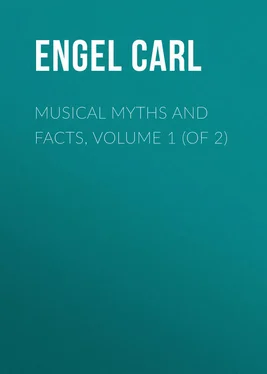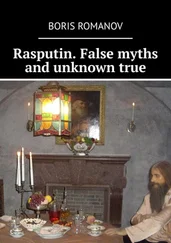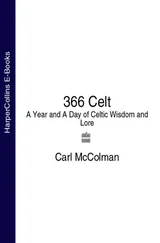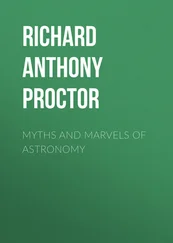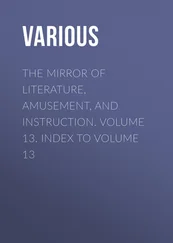Carl Engel - Musical Myths and Facts, Volume 1 (of 2)
Здесь есть возможность читать онлайн «Carl Engel - Musical Myths and Facts, Volume 1 (of 2)» — ознакомительный отрывок электронной книги совершенно бесплатно, а после прочтения отрывка купить полную версию. В некоторых случаях можно слушать аудио, скачать через торрент в формате fb2 и присутствует краткое содержание. Жанр: music_dancing, foreign_antique, foreign_prose, на английском языке. Описание произведения, (предисловие) а так же отзывы посетителей доступны на портале библиотеки ЛибКат.
- Название:Musical Myths and Facts, Volume 1 (of 2)
- Автор:
- Жанр:
- Год:неизвестен
- ISBN:нет данных
- Рейтинг книги:5 / 5. Голосов: 1
-
Избранное:Добавить в избранное
- Отзывы:
-
Ваша оценка:
- 100
- 1
- 2
- 3
- 4
- 5
Musical Myths and Facts, Volume 1 (of 2): краткое содержание, описание и аннотация
Предлагаем к чтению аннотацию, описание, краткое содержание или предисловие (зависит от того, что написал сам автор книги «Musical Myths and Facts, Volume 1 (of 2)»). Если вы не нашли необходимую информацию о книге — напишите в комментариях, мы постараемся отыскать её.
Musical Myths and Facts, Volume 1 (of 2) — читать онлайн ознакомительный отрывок
Ниже представлен текст книги, разбитый по страницам. Система сохранения места последней прочитанной страницы, позволяет с удобством читать онлайн бесплатно книгу «Musical Myths and Facts, Volume 1 (of 2)», без необходимости каждый раз заново искать на чём Вы остановились. Поставьте закладку, и сможете в любой момент перейти на страницу, на которой закончили чтение.
Интервал:
Закладка:
An interesting catalogue of the instruments in the Musée du Conservatoire National de Musique has recently been published by Gustave Chouquet, the curator of the museum. It comprises 630 instruments, or portions of instruments, each fiddle-bow, mute, etc., being separately numbered. On the whole, the Paris collection, though large, is far less valuable than that of the South Kensington Museum.
One of the most valuable private collections ever formed of ancient musical instruments was that of M. Louis Clapisson in Paris. During a course of more than twenty years M. Louis Clapisson succeeded in procuring a considerable number of scarce and highly decorated specimens of instruments of the Middle Ages and the Renaissance. The collection has been dispersed since the death of its owner; a large portion of it is now incorporated with the collection of the Conservatoire de Musique at Paris, and some of its most valuable specimens were secured for the South Kensington Museum. It was, however, so unique that the following short survey of its contents will probably be welcome to the archæological musician.
Clapisson's collection comprised (according to the catalogue of its contents which was published in French, and which is now scarce) 167 instruments. Among them are especially noteworthy: – A clavecin (or harpsichord) with two rows of keys, dated 1612; embellished with paintings which date from the time of Louis XIV. In front is a painting by Teniers, and in the inside are some fine paintings by Paul Brill. An Italian spinet of the time of Louis XIV., embellished with paintings of garlands of flowers, cupids, etc., attributed to Poussin. The fine carving and the ornamentation of engraved amber on this spinet give it a stamp of originality. An Italian spinet, bearing the inscription "Francisci di Portalvpis Veronen opus, 1523," of ebony inlaid with ivory. An Italian spinet of the sixteenth century, ornamented with marquetry of various coloured woods. The corners of the key-board are adorned with caryatides finely carved in box-wood. A travelling spinet made in the shape of a mail-trunk dating from the time of Henri II. It is signed "Marins," which is the name of a celebrated manufacturer of that period. A clavecin made in France in the year 1657, ornamented with paintings and with marquetry of ivory, with the arms of the family of Pierre di Dreux (called Mauclere), Duke of Bretagne, who lived about the year 1250. An Italian dulcimer of wood carved and gilt, dating from the seventeenth century. It is tastefully inlaid with slips of silvered glass. A French dulcimer of the time of Louis XIV., with twisted columns of wood carved and gilt, and with paintings of flowers and birds. A French dulcimer, or timpanon, of the time of Louis XIII., ornamented with roses neatly carved in wood. The instrument is in a case, which is ornamented with paintings and inlaid slips of silvered glass. A French dulcimer of carved wood, ornamented with slips of engraved Venetian glass, with turquoises, and with paintings on Vernis Martin . A sonorous stone from China, in the form of a fish. A French harp, of the time of Louis XV., gilt and carved with flowers and paintings in relief. A harp of the time of Louis XVI., having belonged to the Princesse de Lamballe, whose name is engraven on it. It is finely painted with medallions on Vernis Martin . A theorbo of the time of Louis XIII., inlaid with designs in ivory. Engraven on it is the coat of arms of the House of Austria; also a portrait, and the device Non omnes . A French guitar made, according to an inscription, by Voboam, a celebrated lute-maker at the court of Louis XIV. It is made in the figure of a tortoise, the body being of tortoise-shell, and the head, feet and tail of coloured enamel. A French guitar of the time of Louis XIII., inlaid with ivory, on which are engraven subjects of the chase. A French guitar of the time of Louis XIII., inlaid with ivory engraved with mythological subjects. An Italian mandoline of citron-wood inlaid with mother-of-pearl, engraven with figures. An Italian mandoline, ornamented with marquetry, mother-of-pearl, and carving; assigned to Stradiuarius. A French mandoline of the time of Louis XVI., with the arms of the Dauphin inlaid with mother-of-pearl. A small Italian mandoline with three strings. A mandora of the time of Henri II., inlaid with broad strips of ivory, and with fleurs de lys in ebony. A French hurdy-gurdy (or vielle ) of the time of Louis XIV., made of box-wood and citron-wood, carved, and ornamented with medallions of mother-of-pearl and with turquoises; formerly the property of Madame Adelaïde. A French hurdy-gurdy by Louvet, dated 1750; tastefully ornamented. A small hurdy-gurdy for the use of ladies, made in France during the period of Louis XVI. This vielle , elegant in form and tastefully inlaid with ivory, bears the inscription "Delaunay." A Hungarian violin, made in Presburg, inlaid with marquetry of various coloured woods. A small violin by Jacobus Stainer, inlaid with ornaments in silver, including the coat of arms of France; with a finely-carved head of a faun. A French quinton , or five-stringed viol, made by Guersan, in 1755. A viola da gamba, with a finely-carved head representing an angel bandaging the eyes of a female. A small viola da gamba of the kind on which the French ladies used to play at the time of Louis XIII. A pochette by Stradiuarius, known to be genuine. A pochette of the sixteenth century, of engraved ivory and ebony, inlaid with precious stones. A pochette of ivory and coloured woods, dating from the period of Louis XIII., and bearing the inscription "Marins." A crystal flute, the invention of Laurent; silver keys enriched with amethysts. A small Italian double-flute of ivory, made by Anciuti in Milan, anno 1722. An oboe of ivory, carved by Anciuti in Milan, beginning of the eighteenth century. A French oboe of ebony, inlaid with ivory, tortoise-shell, and enriched with gold and precious stones; of the time of Louis XIII. A small French oboe of the time of Louis XIV., made of ivory, with three silver keys. A French musette (a species of bagpipe with bellows); the pipes of ivory; twenty-one silver keys; the bag ornamented with embroidery in gold. This fine musette dates from the period of Louis XV. A small French musette of ivory, with silver keys, having belonged to the painter Vanloo. A cornemuse bretonne (bagpipe of Brittany) of the time of Louis XIII. A trumpet of the time of Henri IV., ornamented with embossed fleurs de lys and with the portrait of Henri IV., surrounded by butterflies. A serpent of the sixteenth century, made of wood, with the carved head of a demon finely executed.
Turning to Belgium, we again meet with some interesting collections. M. Fétis, the well-known musician, had a number of Eastern instruments procured from Egypt, to enable him to familiarise himself with the Arabic tonal system, which essentially differs from our own, but which undoubtedly is of much higher antiquity, and therefore of particular interest to the musical historian. After the death of Fétis, his collection was purchased by the Belgian Government. Dr. Burney, who visited Antwerp in the year 1772, records in his journal that he saw in a public edifice of the town, called Oosters Huys, a large number of wind instruments of a peculiar construction. "There are," he says, "between thirty and forty of the common flute kind, but different in some particulars – having, as they increase in length, keys and crooks, like hautbois and bassoons. They were made at Hamburg, and all of one sort of wood, and by one maker, 'Casper Ravchs Scratenbach,' was engraved on a brass ring or plate, which encircled most of these instruments. The large ones have brass plates pierced, and some with human figures well engraved on them. These last are longer than a bassoon would be if unfolded. The inhabitants say that it is more than a hundred years since these instruments were used, and that there is no musician at present in the town who knows how to play on any one of them, as they are quite different from those now [in the year 1772] in common use. In times when commerce flourished in this city these instruments used to be played on every day by a band of musicians, who attended the merchants trading to the Hanse Towns in procession to the Exchange."
Читать дальшеИнтервал:
Закладка:
Похожие книги на «Musical Myths and Facts, Volume 1 (of 2)»
Представляем Вашему вниманию похожие книги на «Musical Myths and Facts, Volume 1 (of 2)» списком для выбора. Мы отобрали схожую по названию и смыслу литературу в надежде предоставить читателям больше вариантов отыскать новые, интересные, ещё непрочитанные произведения.
Обсуждение, отзывы о книге «Musical Myths and Facts, Volume 1 (of 2)» и просто собственные мнения читателей. Оставьте ваши комментарии, напишите, что Вы думаете о произведении, его смысле или главных героях. Укажите что конкретно понравилось, а что нет, и почему Вы так считаете.
